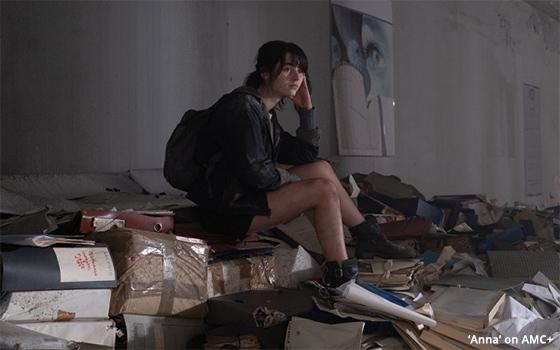
It’s another dystopian drama,
folks -- only this time it’s in Italian.
As if to prove that we all live in a small world after all, the new (to America) series “Anna”
coming to AMC+ this week is an end-of-the-world drama that takes up some of the same themes as the dystopian dramas that have become common for U.S. networks and streamers.
“Anna” depicts a world -- in Sicily but by implication the entire globe -- in which a pandemic has killed every grown-up, leaving tribes of feral children to
fend for themselves among the corpses and ruined buildings of the post-apocalypse.
The show is like “Lord of the Flies” on steroids. And
that’s a compliment. In “Anna,” the stakes are high and the filmmaking is right up there with it.
advertisement
advertisement
The title character -- played by Giulia
Dragotto (pictured above) -- is a girl approaching puberty (which is an important point where this series is concerned) -- who is surviving in a house in the woods with a little boy who is not quite
her brother, but he is close enough.
In Episode One, we see the onset of the pandemic, which eventually claims the grown-ups in Anna’s life. Then we
see Anna’s hardscrabble efforts to survive by scavenging among the wreckage of a destroyed civilization.
The chronological relationship between the
COVID-19 pandemic and the show’s creation, development and production is unclear.
But it did premiere in Italy last April, which suggests that it may
have been inspired by real-world events, although -- obviously -- the deadly apocalypse it depicts did not occur.
This limited series was reportedly
well-received in Italy, which many might recall was hit particularly hard by COVID.
While the word “dystopian” is used to describe so many of
these kinds of dramas (something the TV Blog has complained about in the past to no avail as usual), “Anna” gets a pass based on its unusually high quality.
Despite the tragic, lawless world it depicts -- one littered with corpses, abandoned vehicles and piles of trash -- “Anna” emerges as a beautiful piece of
filmmaking that is integral in the telling of this show’s post-pandemic story.
It fulfills a mission, or some might say an obligation, on the part of
television to tell its stories visually, at least in part and to the extent that it is possible.
In “Anna,” we learn most of what is going from
visual clues. In other words, it shows us more than it tells us. This is rare on television.
This is not to say that there is no dialogue in
“Anna.” There is plenty of it at just the right moments, subtitled of course.
The subtitles raise a question, however, about viewing options
where some of our favorite devices are concerned.
Specifically, on a phone screen, these subtitles would seem to present a challenge for viewing because they
would be so tiny.
That is not really a drawback, however, since it might drive potential viewers to their home TV screens, where a show as beautifully filmed as this one
deserves to be seen and savored.
“Anna” starts streaming on Thursday (November 18) on AMC+.